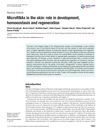TLDR Topical oligonucleotide therapy targets hair follicles effectively.
The study demonstrated that antisense oligonucleotides (ASO) could be effectively delivered into the dermis of BALB/c mice via hair follicles when formulated in a lipophilic cream, but not with saline formulations. The cream's lipophilicity facilitated the ASO's entry through the hair follicles, suggesting that the right hydrophilic/hydrophobic balance in the formulation was crucial for effective dermal delivery. This method showed potential for localized drug delivery to hair follicles and treating skin disorders, though further research was needed to fully understand the enhanced delivery mechanism.
47 citations
,
September 1997 in “Journal of Pharmaceutical Sciences” Properly formulated large molecules can reach active levels at the hair bulb.
37 citations
,
January 1997 in “Journal of Pharmaceutical Sciences” Hairless rats absorb substances through their skin more easily than hairy rats.
 31 citations
,
July 2017 in “Clinical Science”
31 citations
,
July 2017 in “Clinical Science” MicroRNAs are important for skin health and could be targets for new skin disorder treatments.
 29 citations
,
February 2007 in “Hormone and metabolic research”
29 citations
,
February 2007 in “Hormone and metabolic research” Blocking the androgen receptor in skin cells reduces their growth response to male hormones, suggesting a possible treatment for skin conditions linked to androgens.
 45 citations
,
January 2020 in “International Journal of Molecular Sciences”
45 citations
,
January 2020 in “International Journal of Molecular Sciences” Some natural compounds may help overcome drug resistance in certain cancers, but more research is needed.
1 citations
,
November 2005 in “Journal of Andrology” The meeting highlighted promising genetic treatments for male fertility issues but noted concerns about certain cancer risks and ICSI safety.
 January 2023 in “Kafkas üniversitesi veteriner fakültesi dergisi/Kafkas üniversitesi veteriner fakültesi dergisi”
January 2023 in “Kafkas üniversitesi veteriner fakültesi dergisi/Kafkas üniversitesi veteriner fakültesi dergisi” Seasonal changes affect gene activity linked to hair growth in Angora goats.



